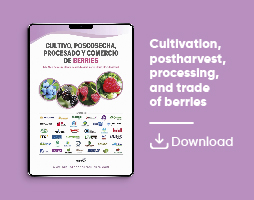News
Banana postharvest physiology and preservation technologies
The paper by Tao Wang et al. reviews banana physiology and storage options, and advocates for innovative preservation via nanotechnology and smart packaging to extend shelf life

Bananas (Musa spp.), as one of the world’s most important tropical and subtropical food crops, hold significant roles in both global food security and the economies of many developing countries. Renowned for their rich nutritional content, high in vitamins, minerals, and carbohydrates, bananas are an integral part of the daily diet for millions of people worldwide (Aurore et al., 2009; Singh et al., 2016).
Major banana-producing countries such as India, Ecuador, Brazil, and China contribute substantially to global production, reflecting the fruit’s remarkable adaptability to a wide range of climatic conditions (Panigrahi et al., 2021).
Extending shelf life and minimizing postharvest lossess, key focus
However, despite bananas’ global importance, their high perishability postharvest presents major challenges for producers, supply chains, and consumers alike (Brat et al., 2020; Martínez et al., 2023; Qamar & Shaikh, 2018). Effectively extending bananas’ shelf life and minimizing postharvest losses has therefore become a key focus in the field of food science and technology.
A climacteric fruit
Bananas are classified as climacteric fruits, meaning they continue to ripen after being harvested. This process is primarily driven by the release of ethylene, a gaseous plant hormone that triggers a series of physiological and biochemical changes, including softening of the fruit, changes in its aroma profile, and color transformation.
While ethylene is essential for the normal ripening process, uncontrolled ethylene production during storage and transportation accelerates over-ripening and spoilage, leading to substantial postharvest losses (Brat et al., 2020).
These rapid ripening processes not only cause economic losses but also exacerbate food waste, particularly in regions where food insecurity remains a critical issue, with bananas serving as a major source of calories and nutrients (Hao et al., 2019; Huang et al., 2016).
Traditional preservation methods
Traditional preservation methods for bananas, such as physical treatments (e.g., refrigeration) and chemical treatments (e.g., 1-Methylcyclopropene, or 1-MCP), have been employed to mitigate postharvest losses.
Refrigeration slows the ripening process by inhibiting ethylene production and reducing enzymatic activity, but bananas are prone to chilling injury at temperatures below 13 °C, which can result in irreversible physiological damage (Murmu & Mishra, 2018).
Chemical treatments, such as the application of 1-MCP, block ethylene receptors to delay ripening. However, growing concerns about chemical residues on food and the environmental impact of these treatments have raised questions about their long-term sustainability and consumer acceptance (Zhu et al., 2015).
Therefore, while traditional methods have proven somewhat effective in extending bananas’ shelf life, they fall short of maintaining the fruit’s quality, flavor, and nutritional integrity over extended periods.
In recent years, there has been increasing interest in exploring more innovative and sustainable approaches to banana preservation, with nanotechnology and biopreservation emerging as promising solutions.
Nanotechnology
Nanotechnology, due to its ability to manipulate materials at an atomic and molecular scale, offers novel opportunities in food preservation.
For instance, nanoparticles can be incorporated into packaging materials to create intelligent packaging systems that respond to environmental changes, such as shifts in temperature or humidity, thus controlling the ripening process more effectively (Lin et al., 2024; Pham et al., 2023).
Additionally, nanomaterials can be used as ethylene scavengers to absorb excess ethylene gas from the storage environment, further delaying ripening (Tas et al., 2017).
The potential of nanotechnology to revolutionize food preservation, particularly for highly perishable fruits like bananas, is immense. However, its safety, scalability, and cost-effectiveness for commercial application require further investigation.
Biopreservation
Biopreservation, another innovative approach, utilizes naturally derived compounds such as plant extracts, microbial coatings, and edible films to inhibit microbial growth and slow down the physiological processes that lead to ripening and decay.
Chitosan, a biopolymer derived from chitin, has garnered significant attention due to its antimicrobial properties and ability to form protective films on fruit surfaces (Lo’ay & Dawood, 2017). Studies have shown that chitosan coatings reduce the respiration rate of bananas, delay cell wall degradation, and extend their shelf life without leaving harmful chemical residues.
Additionally, combining chitosan with other natural substances such as oxalic acid has been shown to further enhance preservation by reducing browning and maintaining quality during storage (Wantat et al., 2021).
Intelligent packaging technologies
Intelligent packaging technologies also represent a promising advancement in banana preservation. These systems integrate sensors that monitor internal and external environmental conditions, such as ethylene concentration, temperature, and humidity. The packaging can adjust its permeability or release preservation agents in response to these changes, ensuring optimal storage conditions throughout the supply chain (Charlebois et al., 2021).
Moreover, intelligent packaging can be combined with Internet of Things (IoT) technology, allowing for real-time monitoring and management of storage conditions, which can significantly reduce spoilage and waste (Yu et al., 2022).
Challenges
Despite these promising developments, several challenges remain in banana preservation. One key challenge is the need for preservation methods that are both effective and economically viable for smallholder farmers and large-scale producers. While technologies like nanotechnology and intelligent packaging offer considerable potential, their adoption may be hindered by high costs and the need for specialized equipment.
Therefore, future research should focus on developing low-cost, scalable solutions that can be easily implemented in diverse agricultural settings.
Furthermore, the long-term safety of using nanomaterials and other innovative preservation technologies in food products must be rigorously evaluated, particularly in terms of their environmental impact and implications for human health.
Need of information regarding storage technologies
While several reviews have encapsulated strategies for preserving the postharvest quality of bananas through the regulation of transport and packaging processes, there is a notable deficiency in specific information regarding storage technologies (Al-Dairi et al., 2023; Huang et al., 2023; Mohapatra et al., 2011; Murmu & Mishra, 2018).
A review with a comprehensive approach
In this review, we adopted a comprehensive approach to synthesize existing literature on postharvest biochemical transformations and storage techniques in bananas.
We started by identifying key factors influencing banana quality degradation, such as enzymatic activities, ethylene production, and aroma transformations. We conducted a detailed examination of these factors across various studies, emphasizing their impact on the fruit’s shelf life and nutritional value.
The review also critically evaluated advancements in preservation technologies, including traditional methods like refrigeration and chemical treatments, as well as emerging approaches such as nanotechnology and intelligent packaging solutions.
Proposal of future research directions
A systematic analysis of these strategies allowed us to propose future research directions focused on improving banana preservation in a sustainable and health-conscious manner.
We anticipate that by integrating these technologies with the specific physiological needs of bananas, it will be possible to extend their shelf life while preserving sensory quality and nutritional value, thereby promoting sustainable food preservation.
Source
Sustaining freshness: Critical review of physiological and biochemical transformations and storage techniques in postharvest bananas
Author links open overlay panel
Tao Wang, Yiting Song, Longxin Lai, Donglu Fang, Weilin Li, Fuliang Cao & Erzheng Su
Food Packaging and Shelf Life, Volume 46, December 2024, 101386
https://doi.org/10.1016/j.fpsl.2024.101386
https://www.sciencedirect.com/science/article/abs/pii/S2214289424001510












